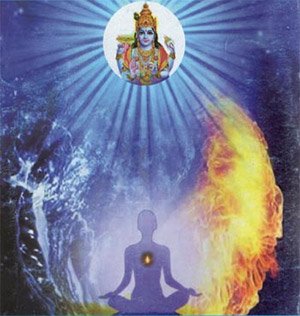Siddhanta Sangraha of Sri Sailacharya
by E. Sowmya Narayanan | 2008 | 30,562 words
Siddhanta Sangraha Chapter 16 (English translation), entitled “the path of surrender” as included in the critical edition and study. The Siddhanta Samgraha is a Sanskrit philosophical text dealing with Vishishtadvaita in five hundred Sanskrit verses. It was written by Shri Shailacarya (18th century) and closely follows the philosophy of Vedanta Deshika (13th century).
Chapter 16 - The Path of Surrender
147. According to nyasa sastra [nyāsa śāstra?], the person who is devoid of the requirements of the bhaktiyoga is eligible to practice the nyāsavidyā. According to scriptural statements and smṛtis everyone is eligible to practice the nyāsavidyā (the path of surrender).
148. The nyāsavidyā which has five limbs should be strictly followed and the sources reveal that it should be done only once in a life time.[1]
149. As the statements of the scriptures, declare nyāsa (surrender) is also the direct means of salvation (mokṣa) like the upāsana (bhakti). The benefits attained by following the other path are easily achieved through nyāsa.
150. While practicing the nyāsavidyā we pray to the Supreme Lord that “Oh God, by being in the means of bhakti or devotion you yourself bestow the fruit of salvation”. As per the nyāsavidyā Īśvara or Nārāyaṇa who has been prayed in the above manner is the (upāya) for salvation and in this practice it is to be understood that nyāsa doesn't require the aspects of bhakti. Surrendering our responsibility to Īśvara or Nārāyaṇa with a prayer to Him to accept the responsibility of protecting us.
151. This has been clearly stated in our theology (siddhānta) as prapatti (self-surrender).[2] Prapatti means that the surrendering of our soul with a prayer for protection to Īśvara or Śrīman Nārāyaṇa.
152. The same definition of prapatti has been explained in the commentaries of Gadyatraya of Rāmānuja and on the authority of the statements like ananyasādhya etc. Hence it should be accepted. In the Brahma sūtra—‘nānā śabdādi bhedāt’ it is stated that the prapatti is also an independent upāya like bhakti due to the difference in their terminology.[3]
153. The difference of the words is very significant and it has been explained in nyāsa viṃśati by Śrī Vedānta Deśika. Therefore, the word prapatti is nothing but the surrendering ourselves with a prayer for protection and it is known as bhara samarpaṇa.
154. The statements of some that the absolute faith is bharanyāsa. It should be understood in the sense that it (prapatti) should be performed with absolute faith.
155. So, there is no difference between the words nyāsa and prapatti as they were seen in the scriptures as synonymous expressions.
156. Both praṇava mantra (OM) and the dvaya mantra conveys the same karma namely, total surrender (bharasamarpaṇa). As there is no difference in both though the mantras are different, there is no distinction between the two expressions. It has to be noted that the scriptures are not quoted to establish prapatti. Whereas in the case of nyāsa which has the vidhivākya (injunctive statements) and also the supportive statement to prove it.
157. Here the question arises about the difference between the nyāsa and prapatti due to the explanation of the scriptures. But it is not correct as the supportive statement is stated only for praising the meaning of the scriptural statement and not to exhibit the difference. Śrī Bhāṣya also supports this view.[4]
158. By the authority of the statement that the prapatti doesn’t expect any supportive statement as in the previous śloka which states that the nyāsa statements are only arthavādas (the statements of eulogy). Here the intention of Śrī Bhāṣyakāra is established.
159. If it is argued that the prapatti is not upāya because as it loses its status as upāya through its own meaning which states that ‘Īśvara alone is the upāya’ then, the argument is not accepted as it is incorrect;
160. The meaning of the above statement is that unlike bhakti which is to be repeated often prapatti is to be practiced only once in one’s life time. It is not to be practiced repeatedly as it is prohibited.
161. The word ‘śaraṇa’ in the statement ‘śaraṇam prapadye’ implies that ‘śaraṇāgati’ or prapatti is not in need of any other means and can achieve the desired end by itself. This alone should be understood with this expression.
Footnotes and references:
[1]:
Ibid pp.115-116
[3]:
See Nyāsa Viṃśati, 10.—See also Brahma Sūtra, III-iii-56.
Conclusion:
 This concludes The Path of Surrender according to Vishishtadvaita philosophy explained by Shri Shailacarya. This book follows the model of Vedanta Deshika although the Vishishta Advaita school was originally expounded by Shri Ramanuja. Vishishta-Advaita is one of the various sub-schools of Vedanta which itself represents one of the six orthodox schools of Hindu Philosophy. They highlight the importance of the Upanishads, the Bhagavad Gita and the Brahma Sutras.
This concludes The Path of Surrender according to Vishishtadvaita philosophy explained by Shri Shailacarya. This book follows the model of Vedanta Deshika although the Vishishta Advaita school was originally expounded by Shri Ramanuja. Vishishta-Advaita is one of the various sub-schools of Vedanta which itself represents one of the six orthodox schools of Hindu Philosophy. They highlight the importance of the Upanishads, the Bhagavad Gita and the Brahma Sutras.
